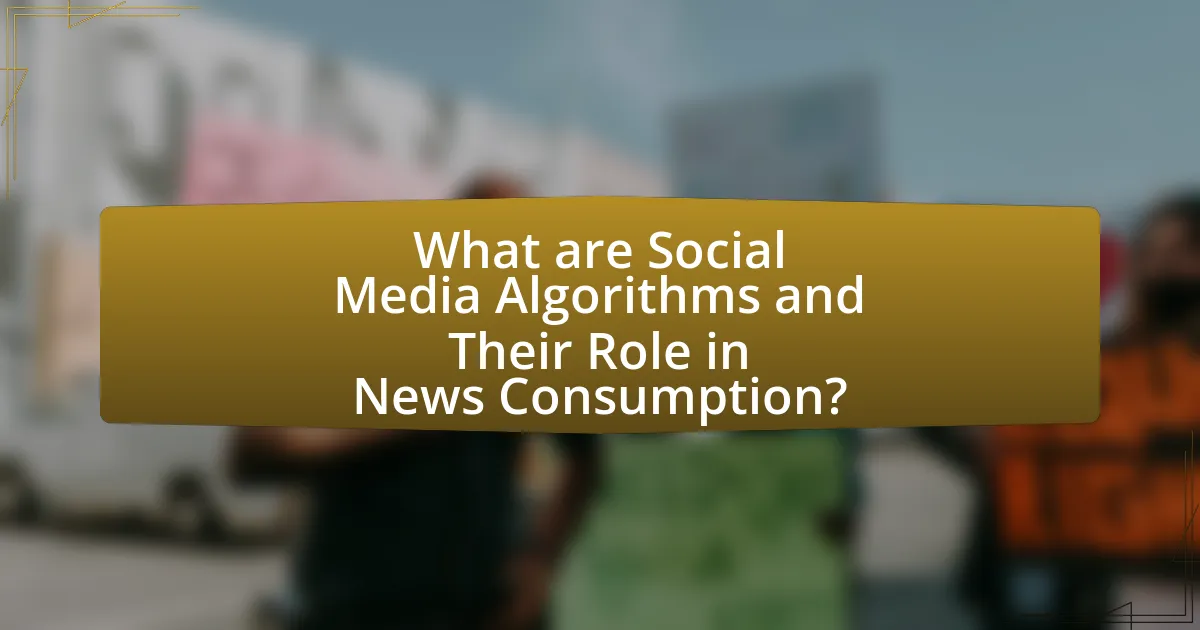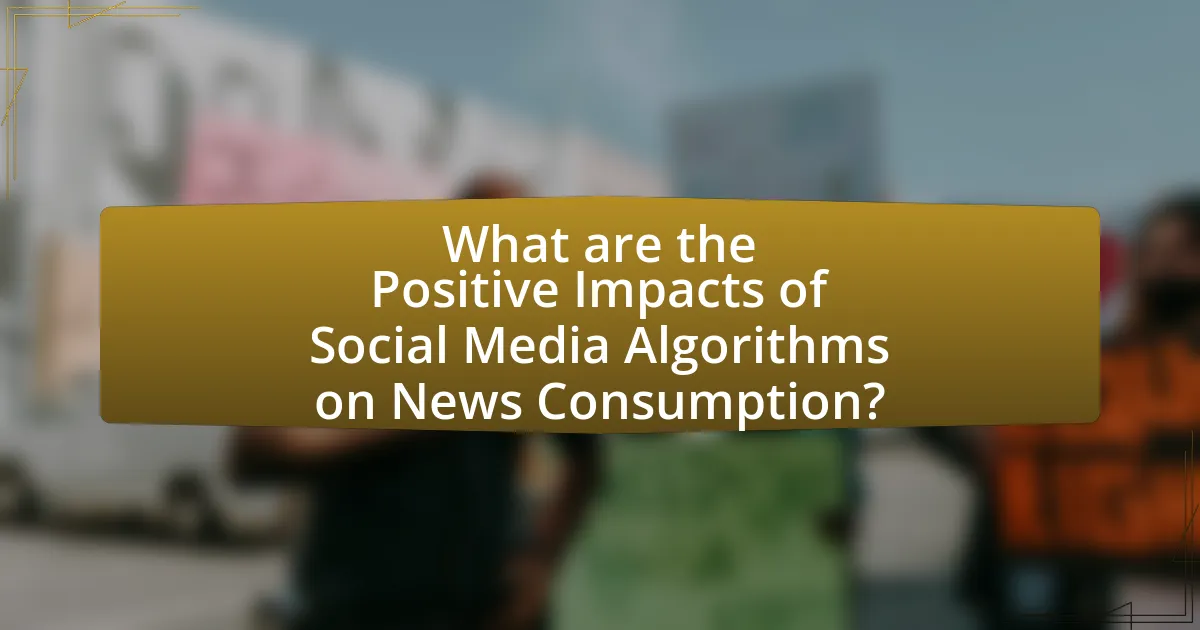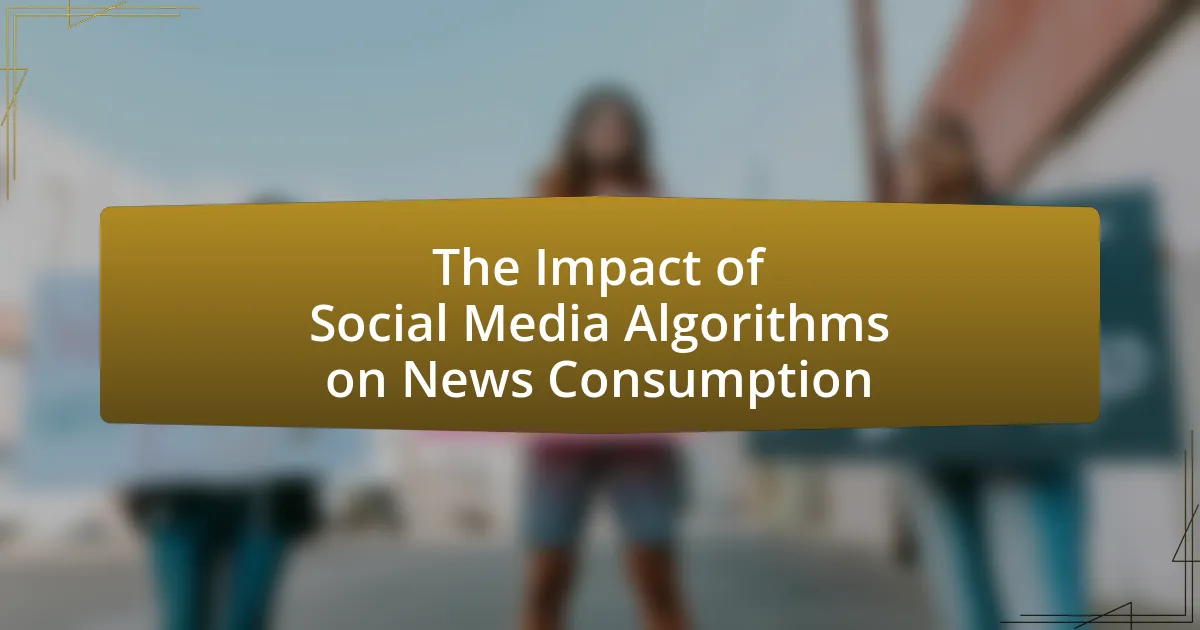Social media algorithms are mathematical formulas employed by platforms such as Facebook, Twitter, and Instagram to curate personalized news feeds based on user behavior and preferences. These algorithms significantly influence news consumption by determining which articles are displayed, often leading to echo chambers that reinforce existing beliefs and limit exposure to diverse viewpoints. The article explores how these algorithms shape news visibility, the factors affecting article ranking, and the implications for misinformation and public discourse. Additionally, it discusses the positive aspects of personalized content delivery and strategies for users to navigate the challenges posed by algorithm-driven news consumption.

What are Social Media Algorithms and Their Role in News Consumption?
Social media algorithms are complex mathematical formulas used by platforms like Facebook, Twitter, and Instagram to determine which content is displayed to users. These algorithms analyze user behavior, preferences, and interactions to curate a personalized news feed, significantly influencing what news individuals consume. For instance, a study by the Pew Research Center found that 62% of Americans get their news from social media, highlighting the algorithms’ role in shaping public discourse and information access. By prioritizing content that aligns with users’ interests, these algorithms can create echo chambers, where users are exposed primarily to viewpoints that reinforce their existing beliefs, impacting the diversity of news consumption.
How do social media algorithms determine what news users see?
Social media algorithms determine what news users see by analyzing user behavior, engagement patterns, and content relevance. These algorithms prioritize news articles based on factors such as likes, shares, comments, and the user’s previous interactions with similar content. For instance, Facebook’s algorithm uses a ranking system that considers the likelihood of a user engaging with a post, which is influenced by their past behavior and the popularity of the content among their network. This approach ensures that users are presented with news that aligns with their interests, thereby increasing the likelihood of interaction and retention on the platform.
What factors influence the ranking of news articles in social media feeds?
The ranking of news articles in social media feeds is influenced by several key factors, including user engagement, recency of the content, and the relevance of the article to the user’s interests. User engagement metrics, such as likes, shares, and comments, signal to algorithms that the content is valuable, thereby boosting its visibility. The recency of articles also plays a critical role, as fresher content is often prioritized to keep feeds current and engaging. Additionally, algorithms analyze user behavior and preferences to determine the relevance of articles, ensuring that users see news that aligns with their interests and past interactions. These factors collectively shape the visibility and ranking of news articles in social media environments.
How do user interactions shape algorithmic outcomes for news content?
User interactions significantly shape algorithmic outcomes for news content by influencing which articles are promoted or demoted in users’ feeds. Algorithms analyze user engagement metrics such as likes, shares, comments, and time spent on articles to determine relevance and popularity. For instance, a study by the Pew Research Center found that 62% of Americans get news from social media, and the algorithms prioritize content that generates higher engagement, leading to a feedback loop where popular articles receive more visibility. This process can create echo chambers, as users are more likely to see news that aligns with their interests and beliefs, further reinforcing their perspectives.
Why are social media algorithms significant for news dissemination?
Social media algorithms are significant for news dissemination because they determine the visibility and reach of news content to users. These algorithms analyze user behavior, preferences, and interactions to curate personalized news feeds, which can amplify certain narratives while suppressing others. For instance, a study by the Pew Research Center found that 62% of U.S. adults get news from social media, highlighting the platform’s role in shaping public discourse. Consequently, the algorithms influence which news stories gain traction, affecting public awareness and opinion on critical issues.
What impact do algorithms have on the diversity of news sources presented to users?
Algorithms significantly reduce the diversity of news sources presented to users by prioritizing content that aligns with their previous interactions and preferences. This personalization often leads to echo chambers, where users are exposed predominantly to viewpoints similar to their own, limiting the range of perspectives available. Research by the Pew Research Center indicates that 64% of Americans believe social media platforms have a negative effect on the way news is reported, highlighting concerns about the narrowing of information sources. Additionally, algorithms tend to favor popular or trending content, which can overshadow niche or less mainstream news outlets, further diminishing diversity in news consumption.
How do algorithms affect the speed at which news spreads on social media?
Algorithms significantly accelerate the speed at which news spreads on social media by prioritizing content based on user engagement metrics. These algorithms analyze user behavior, such as likes, shares, and comments, to determine which posts are most likely to resonate with audiences, thereby promoting those posts more prominently in users’ feeds. For instance, a study by the Pew Research Center found that 62% of U.S. adults get news from social media, highlighting the role of algorithms in shaping news visibility. As a result, news that garners immediate engagement can go viral quickly, reaching a vast audience in a short time frame.

What are the Positive Impacts of Social Media Algorithms on News Consumption?
Social media algorithms positively impact news consumption by personalizing content delivery, which enhances user engagement and satisfaction. These algorithms analyze user behavior, preferences, and interactions to curate news feeds that align with individual interests, leading to a more relevant and tailored news experience. Research indicates that personalized news feeds can increase the likelihood of users engaging with content, as evidenced by a study published in the Journal of Communication, which found that users exposed to algorithmically curated news were more likely to read articles that matched their interests, thus improving overall news consumption.
How do algorithms enhance user engagement with news content?
Algorithms enhance user engagement with news content by personalizing the news feed based on individual user preferences and behaviors. These algorithms analyze user interactions, such as clicks, shares, and time spent on articles, to curate content that aligns with users’ interests. For instance, a study by the Pew Research Center found that 62% of social media users get their news from these platforms, indicating that tailored content significantly increases the likelihood of user interaction. By delivering relevant news articles, algorithms not only keep users engaged but also encourage them to spend more time on the platform, thereby increasing overall consumption of news content.
What role does personalization play in user satisfaction with news feeds?
Personalization significantly enhances user satisfaction with news feeds by tailoring content to individual preferences and interests. This customization leads to increased engagement, as users are more likely to interact with articles that resonate with their specific tastes. Research indicates that personalized news feeds can improve user retention rates by up to 30%, as users feel a stronger connection to content that reflects their interests. Furthermore, a study published in the Journal of Communication found that users exposed to personalized content reported higher levels of satisfaction and perceived relevance, reinforcing the importance of personalization in optimizing news consumption experiences.
How do algorithms help in discovering niche news topics?
Algorithms assist in discovering niche news topics by analyzing user behavior and preferences to curate personalized content. These algorithms utilize data such as reading history, engagement metrics, and social interactions to identify specific interests that may not be widely covered in mainstream media. For instance, platforms like Facebook and Twitter employ machine learning techniques to recommend articles that align with individual user profiles, thereby surfacing niche topics that resonate with smaller audiences. This targeted approach not only enhances user engagement but also enables content creators to reach specific demographics effectively, as evidenced by studies showing that personalized news feeds can increase user interaction by up to 50%.
What benefits do social media algorithms provide to news organizations?
Social media algorithms provide news organizations with enhanced audience targeting and increased engagement. These algorithms analyze user behavior and preferences, allowing news outlets to tailor content to specific demographics, thereby improving the relevance of their news stories. For instance, a study by the Pew Research Center found that 62% of adults get news on social media, indicating that algorithms help news organizations reach a broader audience effectively. Additionally, algorithms prioritize content that generates higher engagement, such as shares and comments, which can lead to increased visibility and traffic to news websites. This dynamic not only boosts readership but also enhances advertising revenue opportunities for news organizations.
How do algorithms assist in targeting specific audience demographics?
Algorithms assist in targeting specific audience demographics by analyzing user data to identify patterns and preferences. These algorithms utilize machine learning techniques to process vast amounts of information, such as user interactions, demographics, and content engagement metrics. For instance, Facebook’s algorithm employs user behavior data to tailor news feeds, ensuring that content aligns with individual interests, which increases user engagement and satisfaction. Research indicates that targeted advertising based on demographic data can lead to a 50% increase in conversion rates, demonstrating the effectiveness of algorithms in reaching specific audience segments.
What are the implications of algorithm-driven analytics for news publishers?
Algorithm-driven analytics significantly influence news publishers by shaping content visibility and audience engagement. These analytics enable publishers to tailor their content strategies based on user behavior and preferences, leading to more targeted and relevant news delivery. For instance, a study by the Pew Research Center found that 62% of Americans get news on social media, highlighting the importance of algorithms in determining which stories reach audiences. Consequently, news publishers must adapt to algorithmic changes to maintain visibility and relevance in a competitive digital landscape. This reliance on algorithms can also lead to challenges, such as the potential for echo chambers and misinformation, as algorithms prioritize engagement over accuracy.

What are the Negative Impacts of Social Media Algorithms on News Consumption?
Social media algorithms negatively impact news consumption by creating echo chambers and promoting misinformation. These algorithms prioritize content that aligns with users’ existing beliefs, leading to a lack of exposure to diverse viewpoints. Research from the Pew Research Center indicates that 64% of Americans believe social media has a mostly negative effect on the way things are going in the country today, highlighting concerns about polarization. Additionally, algorithms often amplify sensational or misleading news stories, as evidenced by a study published in the journal Science, which found that false news spreads more rapidly on social media than true news. This combination of echo chambers and misinformation undermines informed public discourse and can distort users’ understanding of critical issues.
How do algorithms contribute to the spread of misinformation?
Algorithms contribute to the spread of misinformation by prioritizing content that generates high engagement, often amplifying sensational or misleading information. Social media platforms utilize algorithms that analyze user behavior, such as likes, shares, and comments, to determine which posts are shown more prominently in users’ feeds. This mechanism can lead to the viral spread of false information, as studies indicate that misinformation is shared more widely than factual content. For instance, a study published in “Science” by Vosoughi, Roy, and Aral in 2018 found that false news stories are 70% more likely to be retweeted than true stories, highlighting the role of algorithms in facilitating the rapid dissemination of misleading information.
What mechanisms allow false news to gain traction through algorithms?
False news gains traction through algorithms primarily due to engagement-driven ranking systems that prioritize content based on user interactions. These algorithms analyze metrics such as likes, shares, and comments, promoting sensational or emotionally charged content that captures attention, regardless of its truthfulness. Research indicates that false news spreads more rapidly than true news, with a study by Vosoughi, Roy, and Aral in 2018 revealing that false information is 70% more likely to be retweeted than true information. This mechanism is further exacerbated by echo chambers, where users are exposed predominantly to information that aligns with their beliefs, reinforcing the spread of false narratives.
How does algorithmic bias affect the representation of news stories?
Algorithmic bias significantly affects the representation of news stories by prioritizing certain narratives over others, leading to skewed public perception. This bias occurs when algorithms favor content that aligns with user preferences or engagement metrics, often amplifying sensational or polarizing stories while marginalizing diverse viewpoints. Research by the Pew Research Center indicates that algorithm-driven news feeds can create echo chambers, where users are exposed predominantly to information that reinforces their existing beliefs, thereby limiting exposure to a balanced range of news. Consequently, this selective exposure can distort the public’s understanding of critical issues, as the representation of news becomes increasingly homogeneous and less reflective of the broader societal context.
What are the consequences of echo chambers created by social media algorithms?
Echo chambers created by social media algorithms lead to increased polarization and misinformation among users. These algorithms prioritize content that aligns with users’ existing beliefs, reinforcing their views while limiting exposure to diverse perspectives. Research indicates that individuals in echo chambers are more likely to accept false information as true, as demonstrated by a study published in the journal “Science” which found that misinformation spreads more rapidly in homogeneous groups. Additionally, echo chambers can diminish critical thinking and civic engagement, as users become less inclined to engage with opposing viewpoints, ultimately undermining democratic discourse.
How do echo chambers influence public opinion and discourse?
Echo chambers significantly influence public opinion and discourse by reinforcing existing beliefs and limiting exposure to diverse viewpoints. This phenomenon occurs as individuals engage primarily with like-minded peers and consume content that aligns with their pre-existing views, often facilitated by social media algorithms that prioritize such interactions. Research indicates that echo chambers can lead to increased polarization, as users become more entrenched in their beliefs and less open to alternative perspectives, ultimately shaping collective attitudes and societal discourse. For instance, a study by the Pew Research Center found that individuals in echo chambers are more likely to express extreme opinions and less likely to engage in constructive dialogue with opposing viewpoints.
What strategies can mitigate the effects of echo chambers in news consumption?
To mitigate the effects of echo chambers in news consumption, individuals can diversify their news sources by actively seeking out information from a variety of perspectives. Research indicates that exposure to differing viewpoints can reduce confirmation bias and enhance critical thinking skills. For instance, a study published in the journal “Communication Research” found that individuals who consumed news from multiple sources were less likely to hold polarized views. Additionally, implementing algorithmic changes on social media platforms to prioritize diverse content over similar viewpoints can further help break down echo chambers. This approach aligns with findings from the Pew Research Center, which reported that users who engage with a broader range of content are more informed and less susceptible to misinformation.
How can users navigate the challenges posed by social media algorithms?
Users can navigate the challenges posed by social media algorithms by actively curating their content feeds and engaging with diverse sources. By following a variety of accounts and utilizing features like “See First” or “Favorites,” users can prioritize content that aligns with their interests while minimizing algorithmic bias. Research indicates that users who diversify their sources are less likely to fall into echo chambers, which can distort their perception of news (Bakshy et al., 2015, Proceedings of the National Academy of Sciences). Additionally, users should regularly review and adjust their privacy settings and algorithm preferences to enhance their control over the content they receive.
What best practices can users adopt to diversify their news sources?
Users can diversify their news sources by actively seeking information from a variety of platforms and perspectives. This includes subscribing to different news outlets, including international, local, and independent media, which can provide a broader range of viewpoints. Research indicates that consuming news from diverse sources can reduce the effects of echo chambers created by social media algorithms, which often prioritize content that aligns with users’ existing beliefs. For example, a study by the Pew Research Center found that individuals who engage with a mix of news sources are more likely to encounter differing opinions, leading to a more informed understanding of current events.
How can users critically evaluate news content presented by algorithms?
Users can critically evaluate news content presented by algorithms by employing a systematic approach that includes fact-checking, cross-referencing sources, and analyzing the context of the information. Fact-checking involves verifying claims against reputable sources, such as Snopes or FactCheck.org, which provide evidence-based assessments of news stories. Cross-referencing sources means consulting multiple news outlets to compare reporting on the same event, which helps identify biases or discrepancies in coverage. Analyzing context requires users to consider the motivations behind the news presentation, such as the potential influence of advertising or political agendas, which can shape the narrative. This methodical evaluation process is essential in an era where algorithms curate content based on user preferences, potentially leading to echo chambers and misinformation.

Leave a Reply